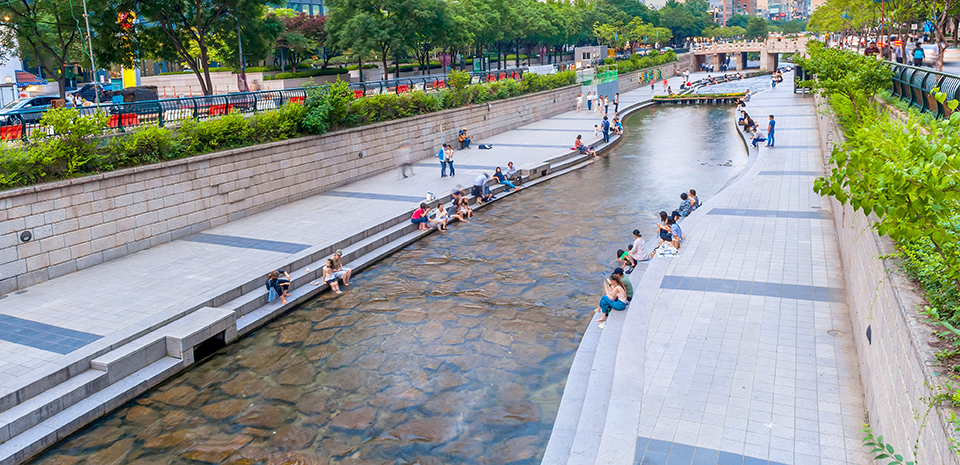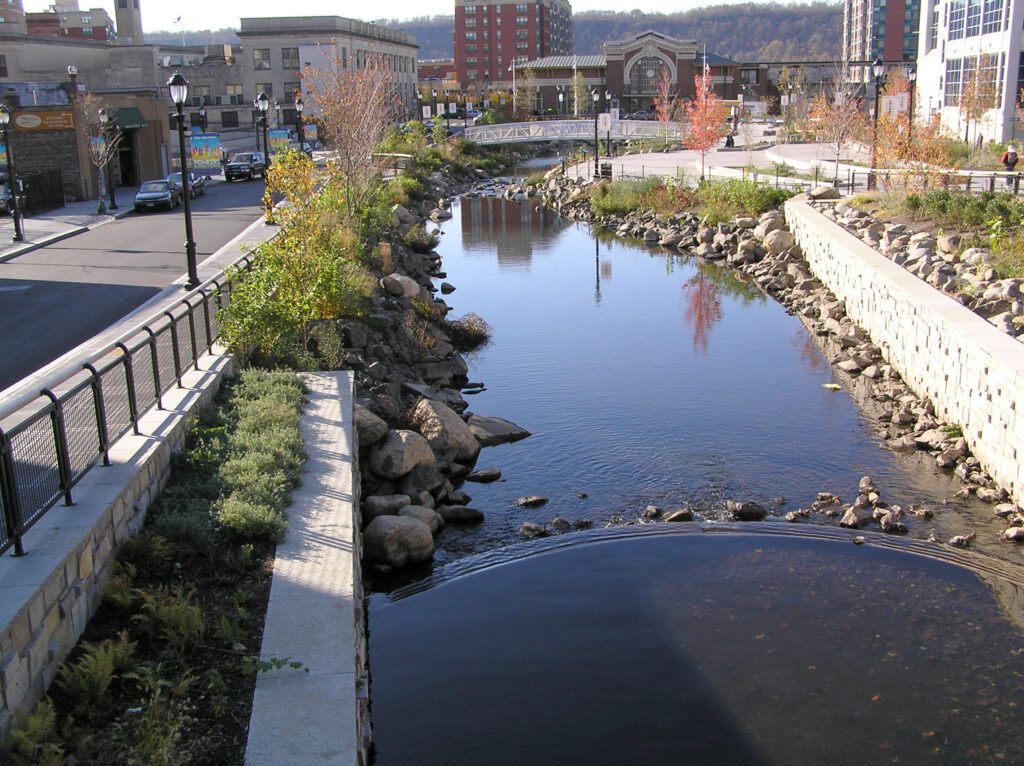When to Consider Daylighting a Stream
Think about the most exciting places to go in your community. In many cases, they are where the water and the land meet—edges of streams or lakes or even oceans. Those areas create interest, value and opportunity. They are where the energy is at.
Throughout the last century, many of the streams and rivers that wind through our cities were buried—diverted through a pipe or concrete tunnel underground to make way for urbanization or a redevelopment of some sort. Essentially, the streams and rivers were erased from the physical landscape. They became parking lots, factories, malls, office buildings or even roadways. They were seen as obstacles for the needs of the time.
However, many cities have begun the process of rediscovering those lost streams over the last few decades. They are daylighting—uncovering and returning the water to a natural drainage system, often making the resurrected streams the focal point of a revitalization project. Those cities are realizing a number of benefits, everything from improved drainage and water quality to an economic rebirth.
The Cheonggyecheon stream revitalization project in Seoul, South Korea, is a great example of how daylighting helped turn a “concrete jungle” into a park. The stream was previously covered by transportation infrastructure. (Apple_Foto/Shutterstock.)
Reaping the Benefits
Cities have become extremely cognizant of long-term maintenance costs for infrastructure. Tearing out a deteriorated pipe and replacing it with a new one is a costly endeavor.
Plus, many communities in America’s largest cities, or within their first ring of suburbs, are now in redevelopment or revitalization mode, seeking to freshen up neighborhoods and create new opportunities for employment. One way to accomplish that is through natural systems such as streams. Natural systems are inherently connected to more amenities than areas served by underground systems. More amenities bring about higher densities of people, establishing an increased property value to the area and an improved quality of life.
Stream daylighting can also assist flood mitigation efforts when proper floodplains are restored to retain floodwaters, whereas conduits often back up and cause increased localized flooding during heavy rains. Other benefits of producing “living” streams include:
-
- Improved water quality
- Runoff management opportunities
- Recreational opportunities
- Wildlife habitat creation
Remember, water running through a pipe is devoid of sunlight, soil and vegetation—things that help remove pollutants and provide the foundation for natural habitats.
The Case for Daylighting
Is stream daylighting appropriate everywhere? Not necessarily. The site location or economics may not be conducive to daylighting. In other places, a stream running through a property can actually be the solution to several problems. Let’s examine some situations when daylighting makes the most sense.
Economic revitalization. Remember when we talked about going where the energy is? Daylighting a stream ultimately can have this effect and revitalize an urban area. A great example of this occurred in Meriden, Connecticut—a project 20 years in the making. Uncovering a stream that passed through the downtown area helped the city address a couple of objectives: assist flood mitigation efforts and create a 14-acre park where an abandoned mall and parking lot once stood on a brownfield site.
The park now serves a dual purpose: The green space plays host to a number of community events, plus the area will store floodwaters during major rain events. The stream corridor has brought people back to the downtown area and stimulated the economy through its amenities and other redevelopment within the city. In this case, daylighting benefited an area underserved by parks and was the preferred plan versus spending millions of dollars to rehabilitate an underground system that nobody sees.
Water quality downstream. When stormwater is piped from Point A to Point B, the goal is to get it there as quickly as possible. There is generally nothing environmental in the process. However, an open natural channel allows for opportunities to meander the stream and slow the water down. Riffles and pools can be added to help settle pollutants and reintroduce oxygen into the water. A natural channel, which could necessitate increasing the right of way to accommodate flood storage during higher flows, helps send cleaner stormwater to the receiving system.
Flood mitigation. Some cities have looked at daylighting a stream to relieve storm drainage systems, many of which were built decades ago and can no longer sufficiently handle the storm flows required for public safety today. Opening up a stream may even help relieve flooding upstream by removing the pinch points that can cause water to back up. In this case, beneficial flood storage is being provided along the entire reach of the daylighted stream.
Here is another example of a daylighting project in Yonkers, New York, where the city’s landscape has been altered significantly. This area used to be a downtown parking lot. (Anthony 22/Wikimedia Commons)
Challenges to Daylighting
Daylighting is a difficult process. After all, everyone has a perspective and a need, so opportunities have to be weighed in a comprehensive fashion. The effort has to be proven economically—and possibly from a socioeconomic standpoint. Would it be a priority for residents who live in the area now, or for future residents? Have all flooding and safety concerns been addressed? Here are three challenges often encountered.
1. Property constraints and champions. Daylighting has to be a like-minded affair because it often requires working with existing property owners. While one property owner may be satisfied having a piped stream run beneath his parking lot, neighbors may be wanting to be part of a revitalization project. Perhaps it is possible to acquire land for a daylighting project, but at what cost? It may require displacing residents.
City influence is related to those property constraint issues. Most recent daylighting projects have been undertaken by a municipality, rather than through private development—and building square footage and parking spaces tend to be maximized within urban areas. So it may boil down to the municipality being able to sell the plan to the local development and public.
2. Utility and transportation conflicts. Many stream repairs are performed to fix utility problems because a stream has downcut or widened and exposed an old sanitary sewer line or water line, running either along the creek or traveling underneath it. There has been degradation of the natural channel. Therefore, maneuvering around utilities before or after a daylighting project could be an obstacle to daylighting in an area.
Transportation challenges may arise as well. Opening up a stream may require building a bridge—or several of them—where it wasn’t necessary before. It may require constructing a new road for area residents.
3. Lack of land mass. Daylighting requires more land than piping water underground. The effort has to make sense. Is there enough land mass where you are considering a daylighting project to construct a channel with natural features, and possibly include recreational amenities such as an adjoining park or trails? Are you truly preserving the corridor and adding value? Will it benefit from a long-term infrastructure standpoint?
Daylighting is a fascinating topic—one that definitely requires careful planning and bold leadership. Halff has accomplished many successful projects along stream corridors to the benefit of our clients, and understands the challenges and opportunities involved with daylighting streams. We have the ability to bring forth an integrated team of engineers, planners, landscape architects, and environmental scientists to design the best and most balanced sustainable solution for your daylighting project.
Want to learn more about daylighting services? Reach out to our Landscape Architecture professionals today!




